Sfouf (Turmeric Cake)
Updated May 11, 2022
Sfouf is a Middle Eastern semolina turmeric cake, made with simple ingredients, no eggs and no butter. It's vegan-friendly, light, delightful
This post may contain affiliate links. Please read our disclosure policy.
How fun is this cake name? Sfouf! *Too fun*
Sfouf is an arabic word that means lines and it’s used here to describe the way this cake is cut into lines. The cake itself is a semolina-turmeric oil-based yellow cake. It’s a simple plain cake with mild flavors and not at all sweet – the perfect light dessert or snack to go with your cup of coffee!
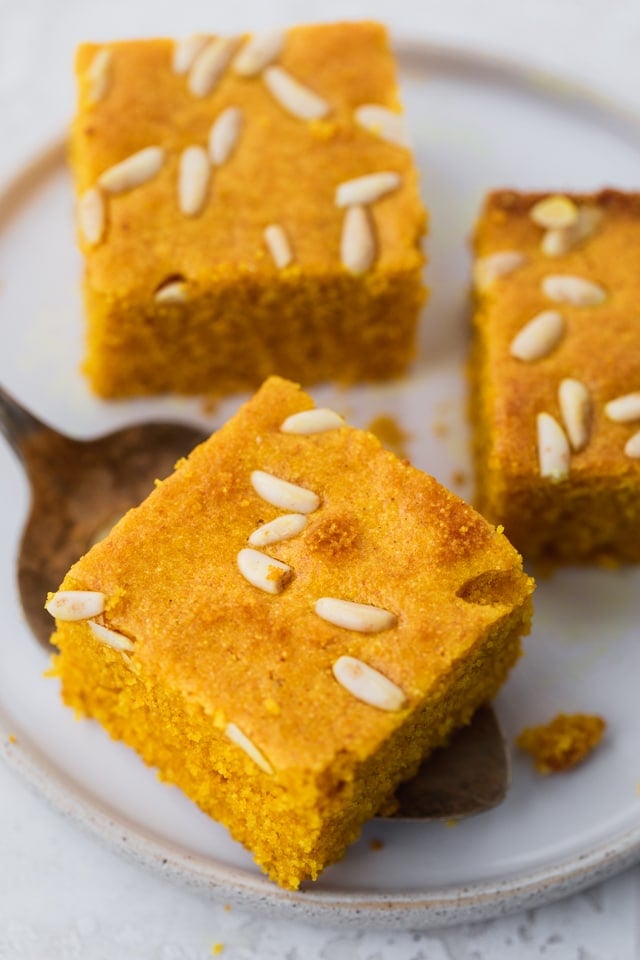
What do you need to make sfouf?
I learned this sfouf recipe from my mom and my mother-in-law. Both essentially make it the same way, but my mom likes to add rose water to the wet ingredients to give it a fresh aromatic flavor.
You only need a few ingredients to make sfouf. The best part is that it’s egg-free and butter-free. And it’s almost vegan, except for the use of 1 cup of milk. You can easily substitute that milk with plant-based milk or water to make this recipe fully vegan.
It’s a super simple recipe that uses basic baking ingredients, but includes three distinct ingredients:
- Turmeric: The turmeric essentially gives the cake a rich yellow color, a sweet and distinct taste, and the added antioxidant benefits. Just one tablespoon of turmeric mixed with the dry ingredients goes a long way.
- Semolina: This is a coarse purified wheat that’s usually used to make pasta. You’ll use the semolina in this cake along with flour to add a nutty texture, compared to just using flour alone.
- Tahini: This is a paste made from sesame seeds. I use it in this sfouf recipe to coat the pan, instead of oil or butter. It’s so widely available in all stores these days. But if you can’t find it, you can coat the oil with oil or butter instead. It just adds to the richness of the recipe.

RECIPE VIDEO TUTORIAL
How do you make sfouf
To start, you’ll want to mix together the dry ingredients: This includes the turmeric and you can see here the color is fairly light before cooking.
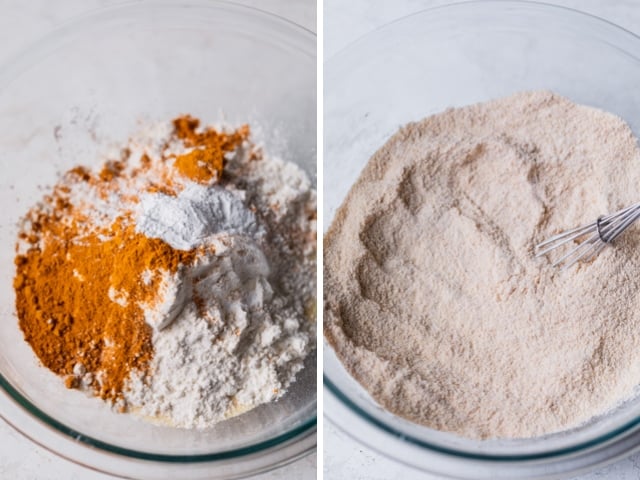
Then comes the wet ingredients. Mix until the sugar dissolves, then combine the wet and dry ingredients together and the batter is ready to go.
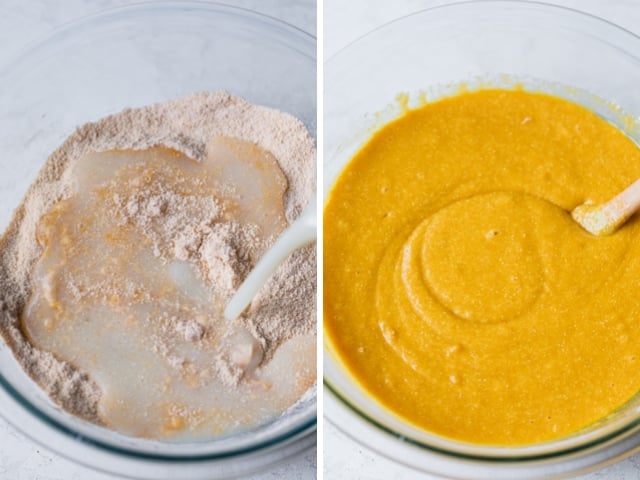
A unique step about this recipe is how we coat the pan. Instead of just using cooking spray, we use tahini to coat the pan. This serves two purposes: first it coats the pan with something oily so the batter doesn’t stick to the pan. And second, it gives the cake a nutty flavor that is pretty iconic of the cake. So after spreading the tahini on the baking pan, you can pour the batter over.
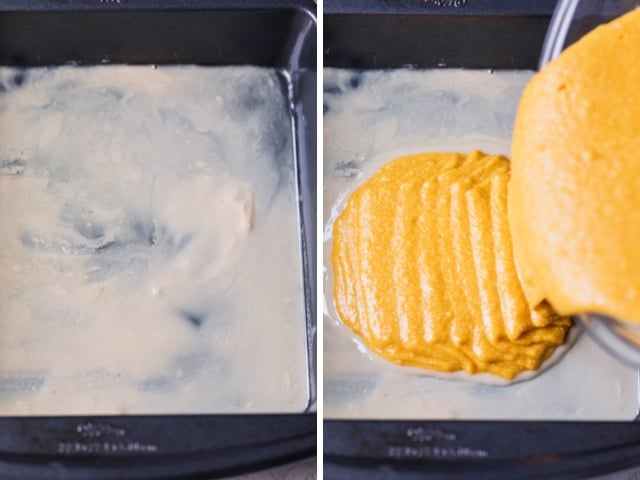
It’s traditional to sprinkle the top of the batter with with raw pine nuts. You can also use almonds, or leave it out completely.
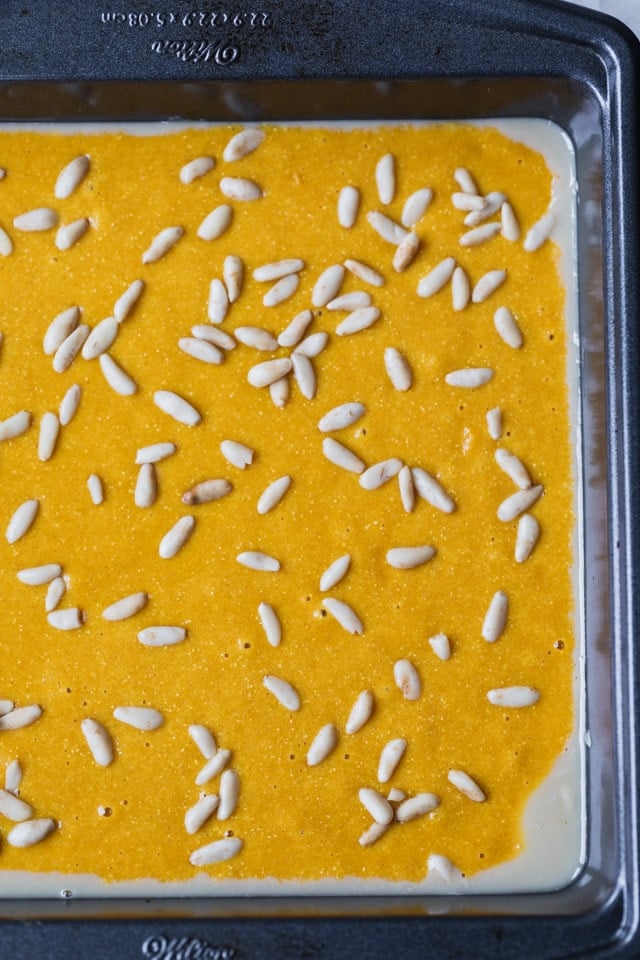
Then you’ll bake the sfouf in the oven for about 30 minutes. Use the pine nuts as a clue to its readiness. You want them golden, but not brown.
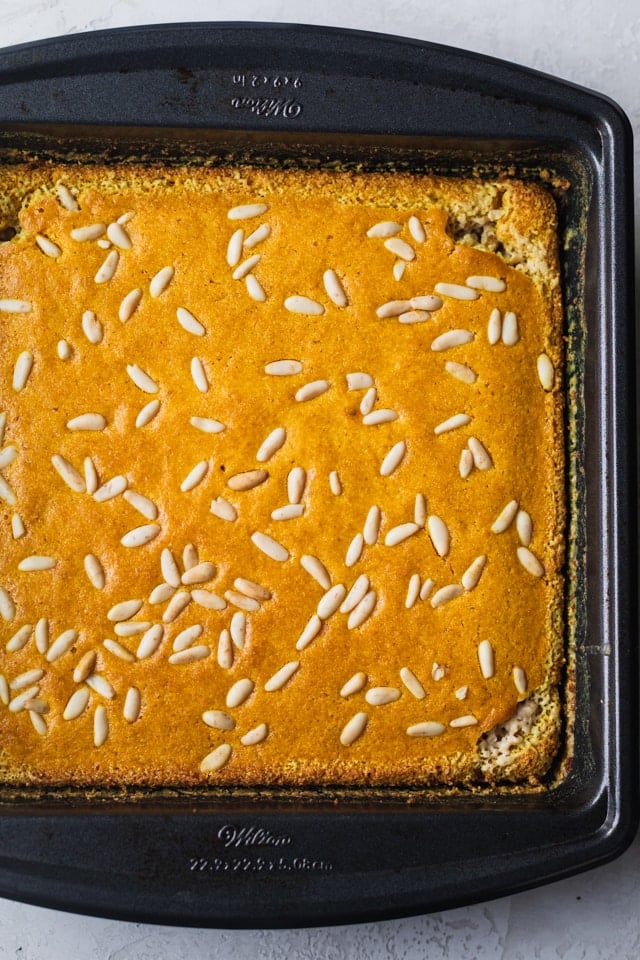
Grab that cup of coffee folks, because it’s sfouf time! You can cut them into squares, rectangles or diamonds – 9 or 12 pieces. The end result is a beautifully colored simple turmeric cake that I grew up eating. It’s one of the most popular Lebanese cakes, and I love how simple it is to make!

Notice how the turmeric color became more enhanced after baking? It’s pretty much turmeric cake, and it’s pretty much one of those iconic Lebanese/Middle Eastern desserts that we grew up having. If you’re obsessed with anything turmeric like I am, try my golden milk latte – it’s basically liquid gold in a cup.

More Middle Eastern inspired desserts:
If you’ve tried this healthy-ish feel good Sfouf recipe or any other recipe on Feel Good Foodie, then don’t forget to rate the recipe and leave me a comment below! I would love to hear about your experience making it. And if you snapped some shots of it, share it with me on Instagram so I can repost on my stories!
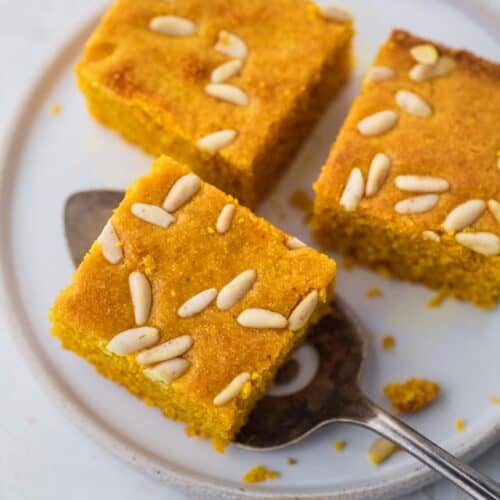
Sfouf (Turmeric Cake)
Video
Ingredients
- 1 ½ cup coarse semolina flour or fine, or mixture of both
- ½ cup all-purpose flour
- 1 tablespoon turmeric
- 1 ½ teaspoons baking powder
- ½ cup neutral oil
- 1 cup milk
- 1 cup cane sugar
- 1-2 tablespoons tahini or oil, to grease the pan
- 1 handful pine nuts or almonds
Instructions
- Preheat the oven to 375ºF and grease a 9×9" baking pan with the tahini sesame oil or other oil.
- Mix the dry ingredients (semolina, flour, turmeric and baking powder) together in a large bowl.
- Mix the wet ingredients (oil, milk and cane sugar) in another small bowl until the sugar is completely dissolved in the mixture.
- Combine the dry and wet ingredients until batter is smooth and bright yellow. Pour the batter into the prepared pan, and sprinkle the pine nuts all over.
- Bake in the preheated oven for 30-35 minutes until the pine nuts are golden.
- Cool on a wire rack and cut into 16 squares or diamond shapes.
Notes
- For tahini, you can substitute oil or butter
- For the coarse semolina, you can also use fine semolina, but don’t use flour instead of semolina because it will not yield the right results
- For the pine nuts, you can use almonds. Silvered almonds work well and make sure they are raw since they will be getting roasted in the oven.
Nutrition
Nutrition information provided is an estimate. It will vary based on cooking method and specific ingredients used.
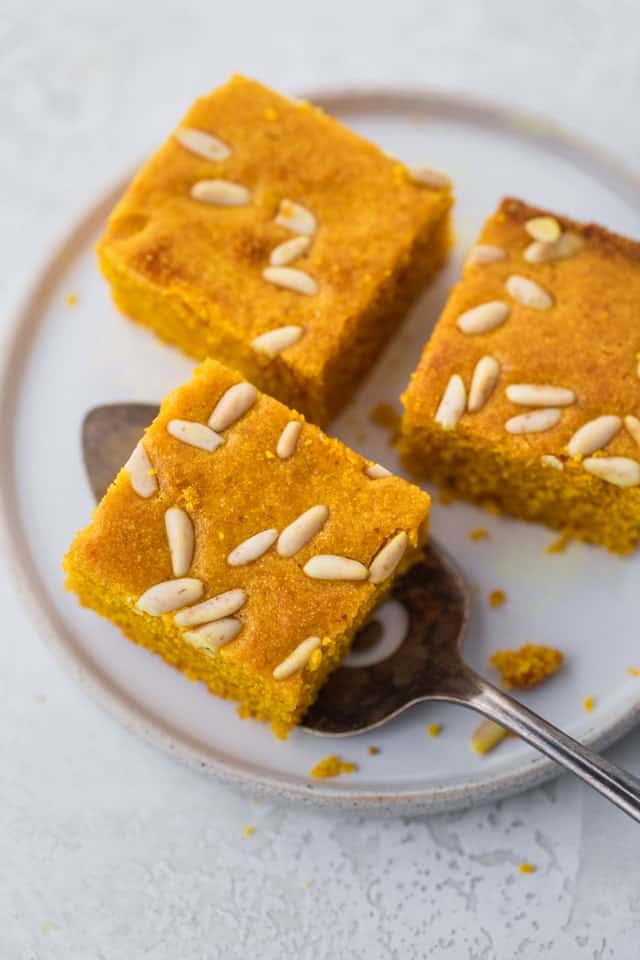






Comments
Update: Second attempt was a success. I used parchment paper and managed to un-mold the cake very easily. I added rose water. I love this cake because it feels very new to me. Like I’m discovering a hidden secret. Because you never see it on Lebanese restaurant menus or in K’nefeh shops. It kind of makes me think of Lent, I don’t know if that makes sense. In Greece there are these very elaborate “fasting calendars” which indicate which days you are allowed to consume dairy, egg … be vegan or eat fish, etc., etc. And Sfouf somehow reminds me of that calendar. I should tell my Greek friends about it.
Yay, so glad it was a success and that you love it!! Sounds like your Greek friends would like the cake too, thank you for sharing it with them!
Hi Yumna! Thanks so much for this recipe. Ever since I had a great success with your olive oil lemon cake, I’ve had the Sfouf cake on my to-do list. I’m enjoying it right now with tea. It tastes so good (and unique) and has a beautiful texture. But I made a mistake, which would probably be very useful information for some readers: I tried to get the cake out of the pan while it was still hot. Unlike other cakes, which come right off (since my pan is non stick), this cake was stubborn. Wouldn’t slip out. Maybe in part due to the Tahini. So I flipped it on to the cooling rack and started banging on the sides to un-mold it… And it broke and crumbled! So moral of the story is wait for it to completely cool down before un-molding. And probably do it gently. Even though it crumbled, it is a pleasure eating it with a spoon. For a cake to just be flavored with turmeric is something very new to me and pleasantly surprising. I am about to have the last bite now.
I’m so happy you loved it, Adam! Thanks for sharing the cooling tip, that will be very helpful for others!!
I like the taste of turmeric but it was a little bit too much for me. However, the texture and the sweetness were spot on. Thanks for sharing this recipe and your culture with us.
So happy you liked it, Mota! You’re welcome!!
Hiya. Can this be made into cupcakes please? Thank you ☺️
Good question! I haven’t tried making this cake into cupcakes but I think it would work. I will say, they may not rise as much as you might hope/expect a cupcake would. But please let me know how they turn out if you end up trying it!!
I just made cupcakes with the recipe. They are great. Rose well
This looks delicious! I’m planning to make this for my Lebanese boyfriend’s birthday. How much rose water would your mother usually add to it? We both love that flavor and I think it would be a nice touch.
Aww, I love that you’re making this cake for your boyfriend’s birthday! My mom adds 1-2 tablespoons of rose water with the wet ingredients. Hope you both enjoy!!
Sounds delicious! Does it matter what type of milk? Soy, cow, almond, oat…
Thank you!
Yes, any milk you prefer will work!
Looks great. Could we substitute whole wheat flour or cake flour?
Hi there, I’m afraid that wouldn’t work out well, semolina is key to the texture of this particular cake.
See All Comments